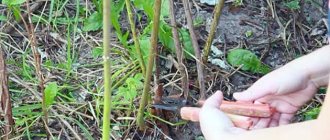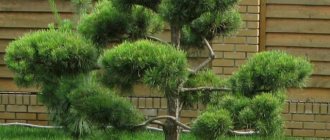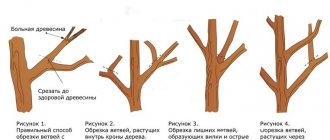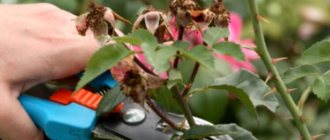Category: Growing and care Reading time: 8 min · Views: 17,467
Thuja is a beautiful coniferous plant for decorating a private yard and estate as a hedge and an element of landscape design. Along with juniper, larch and spruce, thuja has gained popularity among gardeners. In order for the tree to reveal all its decorative potential, it is necessary to carry out pruning in time to form the crown. Pruning thuja depends on its variety and purpose of the tree. Let's consider the issue in detail.
What time of year is it better to cut thuja?
The full growth of a tree or bush depends on the correct month for pruning.
Winter
During most of the winter, tree pruning is contraindicated. In order for the plant to survive severe frosts normally, it is wrapped in special protective covers made of dense agrofibre, and in the spring the covers are removed.
At the end of February, in the southern regions, where winters are not long and warm, you can begin sanitary pruning. The tree is first freed from the protective fabric and given 2-3 days for the branches to take their natural shape. After which the branches with needles can be trimmed.
Spring
Spring pruning for sanitary purposes is recommended. You can start when the air temperature over the last 7-10 days has not dropped below +10 degrees. During this period, it is permissible to transplant thuja and plant cuttings (seedlings) in open ground.
Thuja blooms from the first half of May to early June.
Pruning before flowering begins is used when it is necessary to clear the tree of dry branches and thin out the dense crown. At the same time, the original dimensions of the tree are preserved.
For curly pruning, you must wait until after flowering.
Summer
Summer is the ideal time for maintenance pruning. Young branches begin to look out of place and require intervention.
Haircut recommendations are as follows:
- An inspection needs to be done. Immediately note the areas that need adjustment.
- Thin out the lush and dense crown to ensure normal air circulation. Yellow branches, remove needles.
- When pruning, it is important to ensure that there are no holes and that the needles are evenly dense on all sides.
- If the tree has gone up a lot, you can slightly adjust the height.
- Excessive branches that are too long should be shortened.
You can periodically pinch out young shoots all summer long..
Autumn
Autumn is also considered a good time for sanitary pruning.
From the end of August to the end of September, you need to have time to prepare the thujas for wintering. Branches that are too long need to be shortened so that in winter they do not break under the weight of snow. It is also worth removing diseased shoots.
During this period, replanting and planting of new plants is possible.
Dates
Specific dates for cutting thuja have not been established. This activity can be carried out in the fall and/or spring, mainly as needed, when many damaged or yellowed branches appear or the originally created form has been disrupted.
in autumn
Autumn pruning is performed to prepare the tree for winter so that it can withstand it more easily and without negative consequences. If the branches remain too long, a lot of snow will stick to them, under the weight of which they will become deformed and may break off. Such sanitary pruning is carried out simultaneously with the formation of the crown. The areas of the largest cuts are treated with garden varnish.
In terms of timing, early September is best, but a little later is possible. The main thing is that the event is held at least 2 weeks before the onset of cold weather. Otherwise, sap flow will not have time to recover in the cut shoots and they will dry out. Therefore, before trimming thujas for the winter, you need to study the weather forecast for the current period.
Related article:
Landscaping with thujas
in spring
Pruning thuja in the spring will be more understandable for beginners, since after winter dry and frozen shoots become clearly visible on the tree. Such sanitary treatment not only improves the appearance, but also accelerates the growth of new needles.
It is carried out at the turn of February–March. A more precise period is determined depending on the climatic characteristics of the area, since it is possible to trim thuja correctly only 3-4 days after removing the winter shelter (if it was installed). Under such cover, the branches become a little caked and deformed, so they need to be given time to return to their natural shape.
Decorative pruning can be done together with sanitary pruning in early spring. But many gardeners prefer to trim their plants at the end of April. It should be borne in mind that pruning after flowering has completed contributes to the active growth of needles.
Rules for the formation of the thuja crown
Thuja is a fast-growing plant. In a year, under favorable conditions, it can grow by 30 cm.
A frequently asked question among novice gardeners is whether it is possible to cut off the tops. Yes, you can. There are several reasons for this:
- The bush begins to grow better, new shoots appear.
- A large crown will lead to a lack of light on the lower branches. The needles below may turn yellow.
- When forming a hedge of thuja, pruning the crown is necessary.
To form a beautiful dense green fence, cutting the crown will allow the branches to grow wider, creating a continuous wall.
In summer, corrective pruning is carried out - the bushes are leveled in height.
The first time you need to trim the top by one third. In subsequent years, we need to build on the intensity of growth.
Features of cutting different types of thuja
In the central, southern zone of Russia, western thuja is most often planted. It is unpretentious, tolerates temperature changes, severe frosts, and humidity well. It is divided into many varieties, each of which has its own characteristics in pruning.
Emerald
It is considered the most common type. The needles have an emerald hue. Externally, it looks a bit like cypress. Under favorable conditions it grows up to 5 meters in height.
Other characteristics include:
- It can withstand frost down to -35 degrees.
- Painlessly tolerates heavy smoke and dust from highways.
- Fertile soil is not necessary for planting. Can be grown on sandy, loamy soil.
- Over the course of a year it grows up to 10 cm in height and 5 cm in width.
- One sanitary pruning per year is enough.
- In the first years of growth, a topiary haircut is not necessary, since the plant naturally has a pyramid shape.
Smaragd is suitable for creating garden compositions and a green living fence.
The original variety of thuja - Smaragd Golden - has needles with a golden hue. Does not tolerate dirty air and dust. Not suitable for landing in the center of large cities. The best place for growing is a country house outside the city.
Smaragd is often used to create nivaki - Japanese-style garden compositions. The tree trunk stretches and takes on an unusual geometric shape. Branches are cut or secured in an unusual way.
In addition, spruce, cypress, juniper, and pine can be used for these purposes.
Columna
Columna has characteristics similar to Smaragd.
The exception is rapid growth. Over the course of a year it grows 20 cm in height and 10 cm in width.
It is recommended to carry out sanitary pruning twice a season.
Teddy
Teddy is a new class of western thuja, which was artificially bred by breeders.
In appearance, this is a small, low-growing, dwarf-type tree. It is naturally spherical in shape. The needles are rich green, sometimes a little emerald. With the onset of cold weather it acquires a bronze, brown tone. It doesn't prick. The root system is branched.
Fertile soil is required for normal growth. The plant needs regular watering. Due to its slow growth (2-3 cm per year), it is rarely cut.
The tree reaches its maximum size at the age of 10 years. The average diameter will be up to 40 cm.
Teddy is often used to create mixborders and alpine slides. Craftsmen have learned to grow a tree in a pot using the Japanese bonsai technique.
Kuban emerald
A variety of western thuja. The tree is tall. The shape is naturally pyramidal. Young thuja has soft, non-thorny needles. It gets tougher with age.
The maximum height of the Kuban emerald does not exceed 2.5 m, the crown diameter is up to 50 cm. It is not difficult to care for this variety. The plant is frost-resistant, tolerates polluted air and dust well, and easily adapts to any type of soil.
It is used in the arrangement of park areas, public gardens in big cities and suburban areas.
To plant the Kuban emerald, it is better to choose a shaded place, protected from the wind. Direct sunlight dries out the tree, causing its growth to slow down.
You should not plant it in a draft or in an open area - it will be difficult for the tree to withstand frosts in winter.
Holmstrup
Holmstrup, Wagnery - varieties of western thuja with similar properties. Over the course of a year they grow on average 10 cm in height and 5 cm in width. Sanitary pruning is recommended once a season.
A good option for creating a hedge. The evergreen plant forms a solid wall, which will perfectly protect the area from dust, noise and prying eyes.
Danica
Danica is a variety of spherical dwarf thuja. The height of an adult plant does not exceed 1 m, width - 1.5 m. Frost-resistant. Does not require special care.
To ensure that Danika’s crown is lush and dense, the number of prunings per year increases to three.
But this is not a necessary condition. You need to look at the intensity of growth.
The varieties Hozeri and Woodwardy have similar properties and a spherical shape.
Brabant
Brabant is a popular basis for hedges, decorating park alleys, front gardens, and gardens. With the help of curly trimming, interesting compositions are obtained.
The tree is unpretentious to climatic conditions and soil fertility. Tall specimens reach 20 m in height. But with constant harsh winters, growth stops at 5 m.
The growth per year is 35 cm in height, 15 cm in width.
An annual haircut for your Brabant is required. If this is not done, the crown will lose its splendor and the branches will become spreading. The tree will not be as attractive.
Shapes and Figures
The forms of pruning thuja can be very different. Mostly geometric shapes are used in garden plots. When choosing a configuration, the natural appearance of the tree must be taken into account, so some silhouettes are not suitable for certain varieties.
Before trimming thujas, you must consider the following recommendations:
- The “Smaragd” variety is considered universal and can be cut in almost any way, and in case of an error it is very quickly restored. Most often, it is given a pyramidal or cone-shaped silhouette, and is also shaped in the form of a ball on a leg or animal figures.
- Columnar varieties “Columna” and “Fastigiata” are suitable for strict forms.
- Trimming the thuja occidentalis "Brabant" is most often done in the shape of a pyramid or cone.
- Dwarf "Vudvari" and "Dannika" are easily converted into a ball.
Related article:
6 varieties of thuja that are ideal for decorating a cottage or country plot
How to cut thuja in one way or another is described below.
Cone
Before cutting the thuja into a cone, you need to prepare 3 wooden planks, the height of which will be slightly larger than the tree itself. Next, the work algorithm should be like this:
- the planks are installed close to the crown at equal intervals and the tops are fastened to form a kind of hut;
- branches that make their way between the slats are cut off;
- Having processed the sides, the “hut” is removed and the lower part is cut off.
Sometimes the above haircut option is modified by turning the tip of the cone down. Such a figure has an unfavorable effect on the plant, since its lower part always remains in the shade and does not receive enough sunlight.
Candle
The difference between a candle and a cone is that its top is not sharp, but cut off. To figure out how to properly trim a thuja in the form of a candle, you need to slightly change the arrangement of the strips from the previous description and increase their number to four.
Related article:
The thuja is drying up. How to help
The result should be a frame of four planks located parallel to each other. The cutting process itself is carried out in a similar way.
Pyramid
To trim thuja with a pyramid, the algorithm for creating a cone is also taken as a basis. The only difference is the number of strips used. You can take as many of them as there should be ribs on the pyramid.
During the work, the crown is trimmed on all sides at once. The result is an original symmetrical figure with several edges. The more there are, the more elegant the tree looks.
Spiral
The spiral silhouette looks interesting and unusual, but many people refuse it, considering it difficult to execute. Although this kind of pruning is quite simple. Before properly trimming the thuja with a spiral, a strong rope is attached to the top, wrapped around the surface of the crown and, reaching the bottom, firmly secured to the ground.
Related article:
Evergreen cypress in the garden: photos and views, planting and care
Further work is performed in this order:
- use scissors to cut the needles along the top, focusing on the turns of the rope, creating a base;
- then the branches located inside are trimmed;
- Having created the desired figure, the rope is removed.
The main advantage of this pruning is the variety of types of spirals that you can change yourself.
Ball
When choosing a spherical silhouette, you need to consider which thujas can be cut this way. The easiest way is to create a ball from low varieties, which do not have to be shortened too much, since you can cut the thuja in height by no more than a third of the total volume.
Before cutting a spherical thuja, cut off its top and leave it for some time to build up the crown, which, after trimming the top, will begin to actively grow in width. After this, the branches that extend beyond the intended figure are simply trimmed.
Topiary
Curly pruning of thuja (topiary) is becoming increasingly popular as it allows you to create a wide variety of shapes. For it, a strong wire frame of the desired shape is prepared and installed around the seedling. As the plant grows, branches extending beyond its frame are cut off, and when the figure is fully formed, the frame is removed.
Related article:
6 varieties of thuja that are ideal for decorating a cottage or country plot
This haircut has several advantages. It has an original appearance, can have any shape, and does not subject the tree to severe stress. The downside is the duration of formation and the possibility of installing the frame only simultaneously with planting the seedling or at an early stage of its development.
How to trim thuja yourself
Let's look at step by step how to perform this procedure yourself at home.
Tools
For safety, it is recommended to wear safety glasses and thick gloves when cutting.
You can work (to choose from):
- brush cutter;
- garden shears;
- sickle;
- hacksaw;
- pruning shears
It is best to take scissors with long handles. They are convenient for cutting thujas of any height.
In order not to introduce fungus onto the pruned branches, the tool must be disinfected before cutting, and at the end of the cutting area, apply a special garden paint.
If there are a lot of thujas on the site that need not only sanitary, but also shaped pruning, then it is more convenient to purchase an electric hedge trimmer.
Main stages of work
When planning a haircut, you need to look at the weather forecast. There should be no precipitation on the day of pruning and the next few days. Humid air contains a high concentration of pathogenic microorganisms that are harmful to fresh tree cuttings.
There is no need to rush when getting a haircut. You can’t stick the trimmed one back on later. Therefore, we recommend taking into account the following points:
- The location of the cut is determined by the direction of the branches. If the branch comes from above, you should cut it along the outer bud. Branches lowered to the bottom are pruned, focusing on the lower bud.
- The cut should be made at a level of 1–2 cm from the kidney. This way, the kidney will not die during the healing period of the cut.
- Massive pruning is carried out gradually, not in one day, so that the tree can have time to acclimatize and painlessly endure getting rid of excess branches.
- Most varieties grow up to 20 cm in a year. When cutting a curly haircut, no more than two years of growth is allowed to be removed.
- It is important to remember that you should not expose heavily coniferous branches. They will not be able to quickly grow new shoots like deciduous ones. There is a high risk of branches drying out.
- The crown is carefully trimmed so that there are no gaps or holes. To do this, you need to move away from the tree more often while trimming. From afar, it’s visually easier to see mistakes, places that need to be corrected, or where it’s no longer worth cutting.
- Trees that grow in the shade do not have a very dense crown. Therefore, you should not be zealous with thinning the crown here. Only sanitary pruning is appropriate here.
- You need to work in small areas, gradually moving along the entire length of the tree.
- To make the tree thicken, the internal branches are carefully trimmed from the inside.
Haircuts performed regularly on time will allow you to constantly maintain an attractive crown shape.
Radical pruning will only harm the thuja, slow down growth and generally lead to gradual death. This is especially true for trees that have not been trimmed for several years in a row.
Tree care
If the pruning procedure was carried out correctly, the tree will not experience much stress after trimming. But to increase his immunity, it is still recommended to carry out a number of activities:
- At the end of spring pruning, the bushes are fed with Kemira Universal, a mineral fertilizer. Consumption - 100 g per 1 sq. m. After which abundant watering is carried out. At least one large bucket of water is poured under one tree.
- To spray the branches, the preparations “Zircon” and “Epin Extra” are used. They are diluted with water. They stimulate plant growth.
It is recommended to seal cut areas (when removing large branches) using the following means (optional): Fasco garden varnish, RanNet paste, Robin Green pine balm.
Late autumn pruning should end not only with spraying the branches and processing the cuts, but also with preparing the trees for wintering.
To do this, buy ready-made fabric covers, which allows plants to withstand frost normally. It will be cheaper to make them yourself from dense agrofibre or polyethylene film.
Trimming tools
If you are a non-professional gardener, then it will be enough to acquire such “helpers”.
- Secateurs. Necessary for cutting shoots.
- Garden shears, possibly electric (needed mainly for large plantings for professional trimming). Used for curly haircuts and when you need to adjust the shape.
- Sickle. Used to eliminate large branches.
- Lopper.
- Gloves. Needed to protect the skin of your hands from resin, which causes an allergic reaction. It also washes very poorly.
- Brush cutter.
- Templates and patterns to give the desired shape. If you need to make a rectangular one, you can dig in reinforcement and stretch a rope over the top point.
- Sometimes a metal arch is used.
The main rule is that the entire tool must be very well sharpened (so that there are no kinks on the branches), clean and easy to use, not heavy and convenient. The quantity and varieties depend on the gardener’s goals and the types of thujas, their sizes and varietal characteristics.
If the bushes are large, then more complex electrical mechanisms, such as a trimmer, are often used.
Current issues
Do all thuja varieties need pruning?
Sanitary - yes. Curly depends on the age of the plant, the intensity of growth and type. For example, pruning once a season is enough for Smaragda, but Brabant will have to be pruned at least twice - in spring and autumn.
At what age should you trim thuja periodically?
Recommended age: 6 years. The tree will already have a well-formed root system. Pruning will not be so stressful for him.
Is it necessary to treat cut areas?
If the pruning was done with a sterile instrument, then no. Small branches quickly overgrow as is. But large wounds are better treated. This will speed up the healing process.
Is there a difference in pruning old and young thuja?
No. The technique is the same for all types.
How to understand when thuja will begin to bloom?
In the southern part of Russia it is April, in the middle zone - May, in the northern regions - June.
After pruning, the thuja branches began to turn yellow in places. What's wrong?
The first reason is that the tree simply does not have enough moisture. After cutting, you need to ensure constant watering.
The second reason is getting a haircut on a sunny day. It is better to prune in cloudy weather.
Why is it important to wait for the thuja to bloom for curly pruning?
If this is not done, the tree will simply stop growing and will not achieve the desired splendor. During the period of bud break and flowering, it is permissible to clear the plants of dry branches and yellow needles.
Caring for coniferous plants after cutting
Before cutting, take a close look at the plant. It should be healthy, with good growth and bright greenery. If a plant has many diseased or dry branches, looks dull, it may not survive pruning or it may be very painful. If you are growing coniferous plants specifically to form shapes out of them in the future, you should care for them in such a way that the conifers grow strong and healthy. To do this, they need to be periodically fed, properly moistened, rained and loosened the soil underneath them.
After formation, the conifers are fed with growth stimulants or adaptogens. The needles are treated with Epin, and the soil with Zircon. Haircuts should be carried out one to three times per season. The trimmed parts are excellent as mulch for covering plants for the winter.
Photos of beautifully trimmed thujas
The photo below shows different ideas for decorating thujas, transforming trees into garden sculptures, entire compositions, and provides examples of arranging a hedge from these shrubs.
The process of cutting any type of thuja is simple. Responsible tree care and a flight of imagination are important to make it a beautiful garden figure. Unusually trimmed thujas will decorate the garden area, front garden and will delight the eye all year round.











